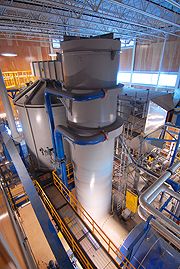UNBC Bioenergy Projects Welcome Conference Delegates and Establish Benchmarks for Performance
June 13, 2012
The last time Prince George hosted its International Bioenergy Conference, UNBC’s Bioenergy Plant was under construction. Now fully operational for one year, the Plant has exceeded expectations for performance and emissions: both critically important to industries and communities aiming to implement or expand their own bioenergy solutions. New results provide evidence that bioenergy can reduce fossil fuel consumption, while utilizing waste products of the forest industry, in ways that have social, environmental, and economic benefits. UNBC’s bioenergy facilities will be featured at the conference, which begins today in Prince George.
In its first year of full operations since Premier Christy Clark opened the facilities in 2011, the biomass gasification system in the UNBC Bioenergy Plant has allowed UNBC to cut its consumption of fossil fuels for district heating by 89%, surpassing the original goal of 85%. Emissions testing has also determined that the system produces particulate emissions at – or even below – the level of heating systems that burn natural gas. The gasification equipment has been provided by BC-based Nexterra Systems.
The Bioenergy Plant has also been the site of a unique experiment that involved using wood pellets as the primary fuel for the facility. Typically, the gasification system uses sawmill residue with moisture content of about 35%. Pellets are much drier, with a moisture content of less than 5%. The trial, conducted in the spring of 2012 for five days, demonstrated that the gasification system can effectively utilize pellets and still operate within normal ranges for equipment operations, energy output, emissions, and overall system efficiency. The trial was the first for a Nexterra system.
The pellets were donated by Pacific Bioenergy for the duration of the trial. Fuel is normally provided by Lakeland Mills.
“As the International Bioenergy Conference begins, we want to recognize our partners and the role they are playing in this project’s achievements,” says UNBC President George Iwama. “For example, Lakeland Mills remains committed to the UNBC project providing biomass for the Bioenergy Plant despite the loss of the mill in April. We can’t thank them enough for continuing to support the advancement of bioenergy, especially in such difficult times. We also wish to thank Pacific Bioenergy for its generous donation of the wood pellets we use at UNBC. Our Facilities staff at UNBC are to be recognized also for continuing to work with faculty and students to use the campus systems to experiment with new ideas or to test new technologies. This is critical if UNBC is to be a model for industry and communities.”
The International Bioenergy Conference and Exhibition Society provides an annual scholarship to a UNBC student pursuing bioenergy research. The 2012 recipient is Kimberly Lawyer of Prince George, who is working with Physics professor Matt Reid on the application of terahertz imaging technology to UNBC’s bioenergy systems. This has the potential to provide an enhanced level of information on air emissions, in real-time.
UNBC has been a partner in the International Bioenergy Conference since its inception. The conference will attract about 400 delegates this year.
UNBC's bioenergy systems have been funded by the Government of Canada's Knowledge Infrastructure and Pine Beetle Recovery programs and the Government of BC's Innovative Clean Energy fund and the Public Sector Energy Conservation Agreement.
More Information


June 13, 2012
|
The last time Prince George hosted its International Bioenergy Conference, UNBC’s Bioenergy Plant was under construction. Now fully operational for one year, the Plant has exceeded expectations for performance and emissions: both critically important to industries and communities aiming to implement or expand their own bioenergy solutions. New results provide evidence that bioenergy can reduce fossil fuel consumption, while utilizing waste products of the forest industry, in ways that have social, environmental, and economic benefits. UNBC’s bioenergy facilities will be featured at the conference, which begins today in Prince George. |
More Information The interior of UNBC's Biomass Gasification building, featuring the oxidizer (centre) and the gasifier behind it to the left. |
Media contacts:
Rob van Adrichem, Vice-President, External Relations, UNBC: 250-960-5622
Alyson Gourley-Cramer, Manager, Communications and Media Relations, UNBC: 250-960-5626